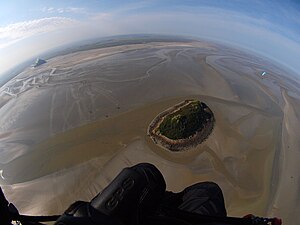Tombelaine
| Tombelaine | ||
|---|---|---|
| Tombelaine | ||
| Waters | Baie du Mont-Saint-Michel | |
| Geographical location | 48 ° 39 '36 " N , 1 ° 30' 46" W | |
|
|
||
| length | 260 m | |
| width | 130 m | |
| surface | 3 ha | |
| Highest elevation | 45 m | |
| Residents | uninhabited | |
| The island of Tombelaine near Le Mont-Saint-Michel | ||
Tombelaine is a small tidal island ( French Île-de-marée ) in the Normandy region , France and is located in the Baie du Mont-Saint-Michel , a bay of the English Channel . It belongs to the Manche department and is 2.5 kilometers north of the northern tip of Mont-Saint-Michel and southwest of the municipality of Genêts . At low tide , the island can be reached on foot.
history
In 1048 the monks Anastase and Robert withdrew to Tombelaine and built the first modest dwellings there as well as a chapel dedicated to Mary (Notre-Dame) .
There are various legends about the origin of the island's name. The first says that the name comes from tombe d'Hélène , "Helene's grave". Whereby it is assumed that Helene was the niece of an English king who was slain by a Spanish giant and was buried on Tombelaine. Accordingly, the priory founded on Tombelaine in the 13th century was mentioned in a document in 1337 as the Prioratum de Tumbahelene . Another legend assumes that the name came from tombe de Bélénos (tomb of Belenus). Since the Mont-Saint-Michel was originally called Mont Tombe ("mountain grave site"), there is a serious theory that Tombelaine is derived from the Latin words tumba (grave site), the diminutive ella and ana and means "small grave site".
In the Hundred Years War (1337-1453) the English built a castle on Tombelaine. During the Huguenot Wars (1562–1598), Gabriel de Lorges (1526–1574) had coins poured from objects that had been stolen from churches on the island. In the 17th century, Nicolas Fouquet (1615–1680), the finance minister of Louis XIV (1638–1715), was suspected of organizing a fronde . Tombelaine was one of the bases of this uprising, so Louis XIV had all the buildings on the island destroyed.
In 1925 the groupement national de la Baie du Mont Saint Michel ("National Association of the Bay of Mont-Saint-Michel") tried to enforce the tourist use of Tombelaine, hotels and casinos were to be built. The French state claimed the island in 1933, classified it as a Monument historique in 1936 and established a bird sanctuary on the island in 1985 . Today seagulls and shelducks nest on Tombelaine. During the nesting season from mid-March to mid-July, the island may not be entered.
Web links
Individual evidence
- ^ Ernest Nègre: Toponymie générale de la France . tape 2 . Librairie Droz, 1996, ISBN 978-2-600-00133-5 , pp. 1021 + 1211 ( in Google Books [accessed March 10, 2010]). (French)
- ^ Ernest Nègre: Toponymie générale de la France . tape 1 . Librairie Droz, 1990, ISBN 978-2-600-02884-4 , pp. 322 ( in Google Books [accessed March 10, 2010]). (French)
- ↑ a b Baie du Mont-Saint-Michel . In: Virginie Maubourguet, Sophie Mastelinck, Odile Simon (eds.): Guides Gallimard . Nouveaux-Loisirs, Paris 1994, ISBN 2-7424-0238-1 , pp. 29 + 198 . (French)
- ↑ Official website of the municipality of Gênets (French). Accessed January 18, 2010
- ↑ Genêts in the Base Mérimée des Ministère de la culture (French) Retrieved March 10, 2010



